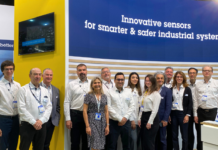
MWC Shanghai 2024 should be memorable, thanks to more than 30 innovative product showcases and demonstrations, nine applications on display, and more than 50 on-site experts. However, beyond exhibiting our latest technologies, the conference is about showing how we can positively impact society. And for those who can’t be there, here’s an overview of three demos that will stand out, not only because of the innovations they feature but the benefits they bring to all. Whether improving accessibility to public services with Bluetooth audio, making lives healthier with the most inconspicuous smoke detectors, or transforming developing economies worldwide, MWC Shanghai 2024 is about the human experience behind our digital lives.
Bluetooth LE Audio on the STM32WBA55
Making audio experiences more interactive

MWC Shanghai 2024 will bring the BLE capabilities of the new STM32WBA54 and STM32WBA55 to life with two audio streaming demos. The first one showcases unicast support by setting up a real-time call between two systems powered by our STM32WBA55. The application demonstrates how developers can use a unidirectional or bidirectional connected isochronous stream. In practice, developers could create a system where a smartphone sends a signal to two pairs of headphones or speakers to share content while also being able to receive an audio stream from these products, like a person speaking into a microphone. Additionally, thanks to our LC3 codec support, developers can improve the quality of the data streamed without requiring greater bandwidth.
Making public service announcements more accessible

The other demo showcases broadcasting capabilities known as Auracast. In a nutshell, Bluetooth Low Energy Audio’s new features enable a source device to stream one stereo or two mono audio feeds to multiple sink devices at once. At MWC Shanghai 2024, our demo will send a signal to two headsets, one speaker, and two cellular devices. A real-world scenario could be an Auracast transmission in a train station to many passengers simultaneously and in two languages (one on each stream), giving users greater accessibility options. Critically, both demos can work with existing smartphones, like the Google Pixel 8. Additionally, we provide application examples for both in our STM32CubeWBA software package.
Air quality sensor with a VL53L8MA
Demystifying the monitoring of air quality
For the first time in Asia, ST is showcasing our air quality demo, which uses a VL53L8MA time-of-flight sensor in partnership with Mobile Physics. Very simply, the application can detect particles as fine as 2.5 µm to determine their concentration in the air and thus measure overall air quality. Traditionally, particulate matter sensors are expensive and serve one purpose. Consequently, it’s rare to find them in anything but devices created for that purpose. However, because ST’s VL58L8 is the same time-of-flight sensor found in smartphones, we can envision the rise of particulate measurement applications on consumer devices since all it would take is an ST sensor already present and Mobile Physics’s software.
Democratizing the tracking of pollutants and smoke
The VL53L8MA is unique because it comes pre-loaded with the algorithm and libraries from Mobile Physics. Additionally, our partner’s SDK can help developers write their air quality measurement applications faster. In the MWC Shanghai 2024 demo, the VL53L8MA sits at the bottom of a case that contains smoke particles. The pollutant is so fine and so few that it’s invisible to the naked eye. When a fan in the case starts blowing up the air, the particles rise, and a UI shows an increase in pollutant levels. Hence, the solution essentially puts a smoke detector in every phone, transforming how we track air pollution and protect against fires.
NFC on feature phones with the ST54L and KaiOS
Bringing NFC technology to emerging markets

Finally, the ST booth at MWC Shanghai 2024 will challenge the definition of a feature phone by introducing a model embarking on an NFC ST54L controller with a secure element capable of acting as a virtual card and NFC reader. The ST device is connected to two antennas: one behind the keypad, which turns the phone into a point-of-sale, and one antenna at the top of the phone to use as a virtual credit or transit card. The first deployment of this technology will take place in Nigeria and represent a major step towards a more modern and inclusive transportation system in the country by enabling people to more easily pay and receive payments.
Transforming lives and boosting economies
To make all of this accessible, ST collaborated with KaiOS, the Chinese company that wrote an open-source operating system for feature phones capable of offering a rich user experience and apps like WhatsApp, YouTube, Facebook, and Google. It also includes the software stack needed to help OEMs and ODMs deploy a feature-rich mobile solution into their markets. Consequently, by adding the ST54L to feature phones and working with KaiOS to make the solution accessible in their operating system, we can offer transit and payment contactless solutions while also leveraging the eSIM capability of the ST device. The demo is, therefore, meaningful to Chinese actors realizing they can enter emerging markets in Africa while transforming people’s lives.











